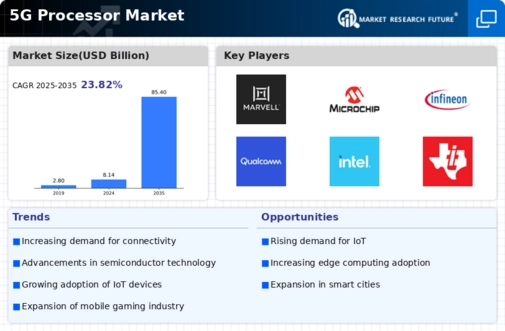Top Industry Leaders in the 5G Processor Market

A Competitive Landscape Analysis Navigating the 5G Processor Market:
The 5G processor market, at its core, is the battlefield where tech titans clash for dominance in the next generation of mobile connectivity. With its potential to revolutionize industries and redefine user experiences, the stakes are high, and the competition fierce. This analysis delves into the current landscape, examining the adopted strategies, key factors for market share analysis, the emergence of new players, and the overall competitive scenario.
Key Players:
- Qualcomm (US)
- Huawei (China)
- Samsung Electronics (South Korea)
- MediaTek (Taiwan)
- UNISOC (China)
- Skyworks (US)
- Qorvo (US)
- Analog Devices (US)
- Broadcom
Strategies Adopted by Key Players:
The market is currently dominated by established tech giants like Qualcomm, MediaTek, Samsung, and Huawei. These players have adopted a multi-pronged approach:
- Technology Leadership: Continuous investment in research and development to push the boundaries of processor performance, power efficiency, and integration. Qualcomm's Snapdragon X70 and MediaTek's Dimensity 9200 are prime examples of this focus on cutting-edge technology.
- Product Diversification: Offering a wide range of processors catering to different segments, from budget-friendly smartphones to high-end gaming devices and industrial applications. Samsung's Exynos series and Huawei's Kirin chips exemplify this strategy.
- Vertical Integration: Investing in chip manufacturing and foundry partnerships to secure supply chains and gain control over critical components. Samsung's foundry capabilities and Huawei's HiSilicon subsidiary are testaments to this vertical integration trend.
- Ecosystem Partnerships: Collaborating with smartphone manufacturers, network operators, and software developers to create a robust 5G ecosystem that leverages the full potential of their processors. Qualcomm's Snapdragon 8 Gen 1 platform and MediaTek's Dimensity Open Platform are examples of such ecosystem-building initiatives.
Market Share Analysis and Key Factors:
Despite the dominance of established players, the market is not static. Analyzing market share requires considering various factors:
- Unit Shipments: The number of smartphones and other devices equipped with each processor provides a basic measure of market penetration.
- Revenue Share: While unit shipments offer volume, revenue share reveals the financial impact of each player, factoring in the price premium of high-end processors.
- Regional Penetration: 5G rollout varies across regions, with Asia leading the charge. Understanding regional market dynamics is crucial for accurate market share analysis.
- Technological Advancements: Continuously evolving processor technologies can rapidly shift market share. Players who consistently deliver cutting-edge solutions can gain a significant advantage.
New and Emerging Players:
The 5G processor market is witnessing the emergence of new players:
- UNISOC: A Chinese chipmaker rapidly gaining traction with cost-effective 5G solutions. Their Tiger T7520 processor is a testament to their ambition.
- Apple: While primarily focused on in-house chips for their devices, Apple's A16 Bionic chip demonstrates their technological prowess and could potentially disrupt the market in the future.
- ARM: Although not directly producing processors, ARM's powerful Cortex-X1 design is increasingly being adopted by chipmakers, potentially changing the landscape of processor architecture.
Industry Developments
Qualcomm:
- Forecasting below-estimate sales: On October 25, 2023, Qualcomm forecasted fourth-quarter sales below market expectations due to a persistent smartphone slump. This led to a stock price drop along with other tech and chip stocks.
- No further sales to Huawei: Qualcomm expects no further sales to Huawei due to the lack of a license to sell 5G chips to the Chinese telecom giant. This impacts their market share in China, where smartphone shipments are down.
- Focus on diversification: Qualcomm is seeking to diversify beyond smartphone chips, with automotive being a bright spot. Revenue from this sector grew 13% in the third quarter due to the increasing use of computer chips in vehicles.
Huawei:
- Open to technology transfer: On January 11, 2024, Huawei expressed openness to transferring all of its 5G technologies, including source code and hardware design secrets, for global innovation. This could be a significant development for the 5G market if successful.
- Patent leadership: Huawei holds the most number of patents for 5G technology, giving them a potential edge in future development.
- Trade restrictions: The ongoing trade restrictions between the US and China continue to impact Huawei's ability to access key components and technologies needed for 5G processor production.








